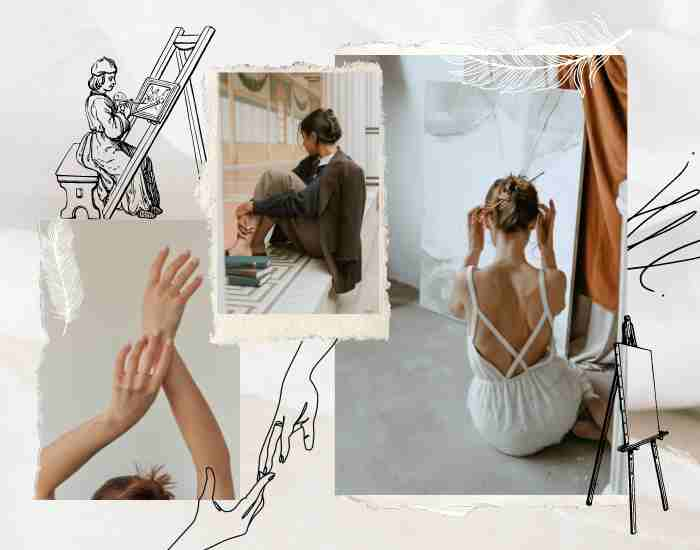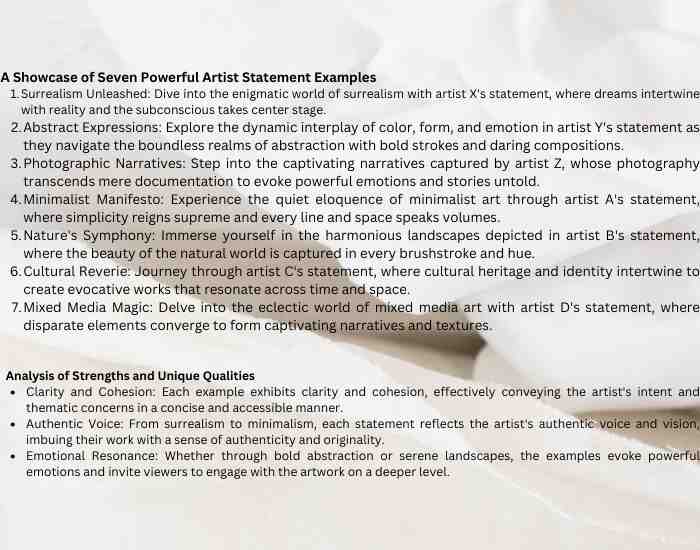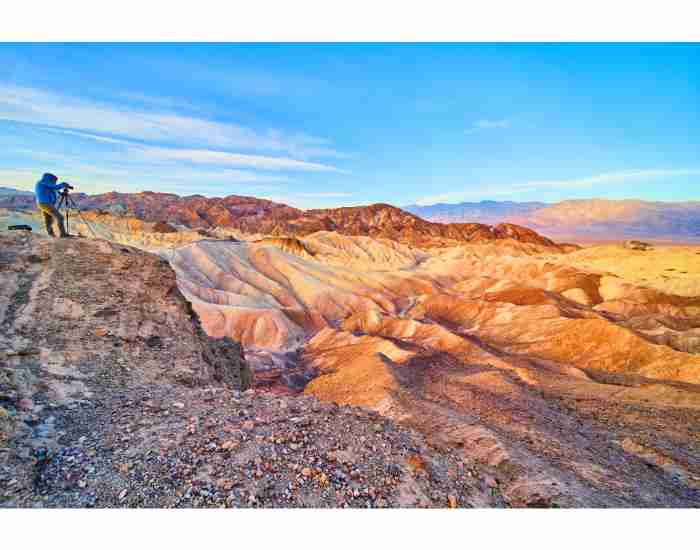In the vast and dynamic world of art with its intersections of colour and creative, artist statements have to be among the best imaginable tools that offer insight into the work of the artist through the eyes of that particular artist. These concise narratives have a purpose, which is to help in bridging the gap between the artist and the audience, thus creating more understanding and affection.
One of the most challenging tasks is when an artist tries to write an artist or rather an effective artist statement, which is only a few words in its totality, but it descries a particular sentence capturing the specific thoughts:::: an artist explains the environment or the emotions that went through them when creating that specific piece of art There is even an argument on what an Instagram caption should be as there is so much to tell.
During the subsequent sections of this post, we will focus on the important elements of the artist statements and where they lie in the hierarchy on the Importance of Art in Society and also learn the art of writing them concisely. Understanding how is the best way to create an artist statement, we would be providing you with examples and guidance in order to create one on your own. So, if you are an experienced artist seeking to improve your artist statement or a beginner seeking to develop your skills, this is the right place to be, as we’ll be diving deeper into the necessity of art.

Statements of artists have served as a glimpse into the process of creation by giving an impression of the pervading keep them going such as their motivations, inspirations, and philosophies. Basically, they are simple statements that artists have summarized and formulated in written form in order to further explain their visual art work.
What is an artist statement?
An artist statement can be described as a written document which mentions some facts regarding an artist’s practice, influencers, and themes of interest to that artist. In terms of its role, it acts as a link between the artist and the viewers as it gives some sense to the rationale behind the artist’s work. Although its structure may differ for example from a single paragraph to an extensive essay, the core principle remains unchanged: state the purpose of the artist and explain the back ground of their works.
Why do artists write artist statements?
Artist statements are important documents in the context of art as they serve as navigation devices for viewers exploring the complex terrains of galleries and exhibitions. The documents enable viewers to orient themselves to the specific themes, techniques and ideas relevant to the particular artwork on display. In addition, these statements support engagement with the artworks and artistic intent in a way that establishes stronger ties between the artist’s intention and the audience interpretation of it.
The intention of the work and the connection with the audience
Artist statements are vital in expressing an artist’s intent and connecting with the audience so that they understand the ideas behind the artwork. This enables them to understand the background stories and the reasons for the creation of such artwork. By engaging with the audience through stories, philosophy, or the technical aspects of the work, the audience is invited to participate in the artwork’s creation process.
The significance of simple yet clear statements and using active voice in all the works.
Great detail as well as simplicity and brevity are essential when writing artist movements.Viewers of different kinds can appreciate a variety of works in art when the complex thematic language is exchanged for simple statements that get the message across. Moreover, the active voice makes it clear to the viewer that they have to participate in the story of the artist by adding a sense of immediacy and strength to the statement. The obliteration of terminology in use during academic studies, and jargon respectively encourages participation which helps viewers appreciate the artist’s hard work regardless of their background.
Creating a Statement of an Artist
The process of creating statement of an artist is a delicate one as it requires both self-reflection and creativity. In case you have a considerable amount of experience in writing or none at all, you can perfect these statement and voila, every piece of your work speaks volumes to your audience.It is important to note though, that Both first person and active voice work.
Emphasizing first person and active voice
Well, both first person and active voice can be deployed when an artist wants to talk about him or herself when addressing the audience in the form of an engaging artist statement Such words are: I want you to see. So on and so forth. We do the same in terms of the voice although there is the difference. Instead of writing, “The artwork was created,” write, “I created the artwork.” Less passiveness means more engagement and emphasis in the statement.
Tips Related to Recognition and Explanation of Subject matter and Themes
Artworks always have a specific subject matter and themes and making sure you don’t forget to address the subject and the themes is extremely important while writing the artist statement which by the way is an integral part of any pieces of artwork. In this case it makes sense to first consider the symbols or the stories that seem to recur in the artist’s artwork. Which themes are most strongly found within you? What subjects do you often seem to work on? After having identified those elements do not just ignore them, incorporate them into your statement considering the meaning along with the context and purpose of your work and why you create.
Look into the creative process
Every work of art is first imagined through thought and that action is referred to as the creative process. This is a very important process and so should be included in an artist statement. Explain how your artistic process proceeds from the first spark through to the last stroke of the brush or camera click. Probably the most important aspect of art-making – the actual making of art – so much happens in the ‘background’ that it remains invisible for the voyeurs and what has gone into the making of that artwork can amaze them. Whether you spend weeks constructing or like working on it in an unplanned manner alter and maintain the details of your process, not only emphasizing it but also demonstrating the change in emotions in the viewer.
Citing Artist Statement Examples For Inspiration
using artist statement examples for inspiration can be quite a journey as it reveals how writers, artists or any other type creators ground their works in different approaches, styles, and voices within the art world. The practice of employing a wide variety of statements helps the artists learn some useful tips and techniques that suit their working style while practicing their distinct approach to art.

A Showcase of Seven Powerful Artist Statement Examples
- Surrealism Unbound: Read artist X’s statement to get used to the idea that surrealism is an activity of the dreams and subconscious as realism and the challenges of days are but a backdrop.
- Abstract Narratives: Understand the books that Y has written where he employs abstraction in full force, guided by the bravado of color, form, and emotion.
- Photographer’s Poems: Feel the powerful undercurrents and emotions embedded in every photograph taken by artist Z rather than call it documentation of photographers eye capturing beautiful images.
- Minimalist Dawning: Wallow into the beauty of minimalist works through artist A’s explanation, where there’s elegance even in absence — all you need is to pay attention, every line and every space tells a story — every single one.
- Landscape Poetry: Live and enjoy the quotes of the folds of the earth written in every stroke and hue, shared in artist B’s statement as the definitions of the worlds of nature and art merge.
- Cultural Daydream: Get mesmerized with animations that transcend time and space as hats and clothing made after artist C’s statement explain the wonders of combining cultures and heritage to narrate something unique.
The ability to analyze someone’s strengths and exceptional capabilities is a skill that every artist must possess
- Voice strength: Every given example stands out to the viewer in such a way that effectively encapsulates the artist’s intended voice and the theme intended to be dealt within it’s pages.
- Emotional Quality: Juxtaposing the numerous examples is distinct dark and light themes running through when looked at during the scenes, adding emphasis on and making the viewer more connected when looking at the artwork.
- Vision: The pages bring out strong pieces yet retain the original vision of the artist, the explosion of creativity to say the least is a feast to the eyes.
While reading the changes made in the artist statement examples, you will be able to pick out parts which stand out to you – an integral part of an artist. While seeking out inspiration in others, it is perfectly fine but cut out elements that do not coincide with your own vision. You want the statement to be an insight into your personality as an artist, and into your work, inviting the viewer into a world that is purely your imagination. Try to see the examples as motivation to get your creative side going, but do not copy, and tell your rendezvous solely through your own visuals, remember to be unique.
How to Craft Your Own Artist Statement
The first step that needs to be taken in order to write and own your own artist statement, is to be ready to go into a very deeply personal and inward journey that involves a lot of self consideration and most importantly self reflection. If you are a first timer, dont worry, this blog is exactly for you, there is no need for apprehension, I’m going to go step by step with you through the process, we’ll together write you an artist statement that reflects who you really are.
Step 1: Reflect on Your Artistic Lasting Impressions
Begin by taking some time to reflect on your artistic journey. Consider the themes, motifs, and techniques that define your work. What inspires you? What messages or emotions do you hope to convey through your art? Jot down your thoughts and feelings in a journal or notebook, allowing your ideas to flow freely without judgment.
Step 2: Use a Blank Canvas to Express Yourself
Next, engage in free writing and brainstorming to generate ideas for your artist statement. Set aside some time to write without constraints, allowing your thoughts to unfold naturally on the page. Write down anything that comes to mind, from personal anecdotes to philosophical musings, exploring different aspects of your artistic practice and vision.
Step 3: Identify Goals and Central Motifs
As you read your free writing and brainstorming sessions, try to pinpoint the dominant themes, motifs, and goals present in the material. Why did you create these works? What do you want your audience to see or understand? Ensure that you articulate them clearly in your artist statement.
Step 4: Write Down Your Thoughts As They Come To You Avoiding Any Complexity Or Wordiness
Taking into consideration your themes and objectives, it is now time to start drafting your artist statement. Since your introduction is critical, start with a brief self-introduction followed by the general nature of your art practice. Next, introduce the readers to the themes, motifs, and goals of your work, providing all the necessary information in simple terms. And give them a first-person account in the active voice and make them feel realistic.
Step 5: Get the External Perspective
When you are finishing your artist statement, get feedback from other artists, mentors or peers from your artistic environment. Get the opinions of different people on your perception of why and how art suits you best. Pay attention to the feedback given and the suggestions made and be willing to make changes that will fortify your statement. By getting feedback from other people, they are able to help you improve on your statement.
Step 6: Complete the Artist Statement
Remember to look at the artists statement feedback that you received and make the necessary changes for the final piece. Once satisfied, you can finally share the world with your creative piece. You can also post the statement on online portfolios, exhibit materials, or your website where you are showcasing your work. For your audience who are supporting your artistic vision, they understand the essence represented in the statement and would love to support your journey.
Conclusion
Creating an artist statement signifies creating art at a different level, it requires deep thinking, self-reflection and honesty. You should practice the steps that we have outlined in this post together with the examples provided so that you can be able to write a statement concerning your artistic work which is likely going to strike your audience’s emotions.
Use words as instruments to explain your ideas and aim for clarity and honesty in reaching out to your audience. Whether you are an experienced artist who wants to change or update your statement or a beginner who has no statement and is willing to create one, do take this chance to explain your story and let others see your artistic world. Begin writing your own artist statement, and be ready to contribute to the art community that is waiting for your artistic proof tomorrow.




